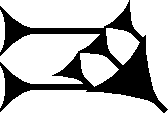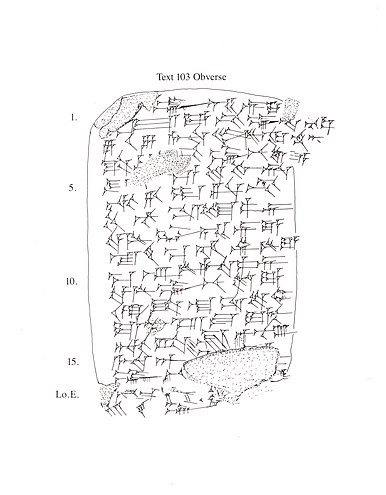
The cuneiform ru sign is found in both the 14th century BC Amarna letters and the Epic of Gilgamesh. As ru it is used for syllabic ru, and alphabetic 'r', or 'u'. In the I-XII Tablets of the Epic of Gilgamesh, it has specific uses showing alternate renderings besides ru; as sign no. 068, ru, 250 times, šub, 6, šup, 3, and as Sumerogram ŠUB, 1 time. In the Amarna letters, the sign is mostly used for ru, r, and u in the spelling of various words. Notably, for "bird", Akkadian language "iṣṣūru", in Amarna letter EA 28,, titled "Messengers Detained and a Protest"; the messengers are referenced as "uncaged" birds, and "aren't they free to come and go as birds do?".
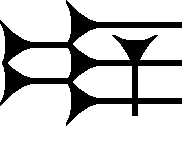
The cuneiform sign for tur is used to denote one syllabic usage, tur, or the sign's Sumerograms; it is used in the Epic of Gilgamesh and the 14th century BC Amarna letters. The sign is based on the i (cuneiform) sign, with the one small added vertical stroke.

The cuneiform qut sign, sign is found in both the 14th century BC Amarna letters and the Epic of Gilgamesh. It is a multi-use sign with 9 syllabic/alphabetic uses in the Epic of Gilgamesh; in the Amarna letters it is extremely common in the prostration formula, typical first paragraph of a letter, saying typically: "7 and 7 times,I bow down" ; a small group of Amarna letters are addressed to a different distinct personage in Egypt, under the Pharaoh.

The cuneiform Aš sign, is found in both the 14th century BC Amarna letters and the Epic of Gilgamesh. In the Epic, it has the following meanings, besides aš:

The cuneiform KÚR sign is used extensively in the Amarna letters. It also has a minor usage in the Epic of Gilgamesh. Its usage in the Amarna letters is due to the letters' topics of "hostilities", "war", or "warfare" in the discord amongst the city-states and the regional discord in the Canaan region. A large subset of the Amarna letters are written by vassal kings in governorship of cities, towns or regions in Canaan.

The cuneiform i sign is a common use vowel sign. It can be found in many languages, examples being the Akkadian language of the Epic of Gilgamesh and the mid 14th-century BC Amarna letters; also the Hittite language-(see table of Hittite cuneiform signs below).

Cuneiform sign nu is a common use syllabic, or alphabetic. It is restricted to "nu", but in the Epic of Gilgamesh, or elsewhere has a Sumerogram use NU, and probably mostly for a component in personal names (PN), god's names, or specialized names for specific items that use Sumerograms.

The cuneiform sign LÚ is the sign used for "man"; its complement is the symbol for woman: šal. Cuneiform LÚ, is found as a Sumerogram in the Epic of Gilgamesh. It also has a common usage in the 1350 BC Amarna letters as the Sumerogram for "man".

The cuneiform na sign is a common, multi-use sign, a syllabic for na, and an alphabetic sign used for n, or a; it is common in both the Epic of Gilgamesh over hundreds of years, and the 1350 BC Amarna letters. In the Epic of Gilgamesh it also has sumerogramic usage for NA. An example usage for NA in the Epic is for the spelling of NA.GAD,, for Akkadian language "nāqidu", "herdsman". The usage for NA in herdsman is only for 3 spellings.

The cuneiform ha sign comes in two common varieties in the 1350 BC Amarna letters. It is also found in the large 12-chapter (Tablets I-XII) work of the Epic of Gilgamesh. Cuneiform ha is used as a syllabic for ha, and an alphabetic for h, or a; from the Epic of Gilgamesh it also has two sumerogramic uses (capital letter (majuscule)), for HA (Akkadian language zittu, for "share"), and KU6, for nūnu, "fish".

The cuneiform bad, bat, be, etc. sign is a common multi-use sign in the mid 14th-century BC Amarna letters, and the Epic of Gilgamesh. In the Epic it also has 5 sumerogram uses. From Giorgio Buccellati 'comparative graphemic analysis', of 5 categories of letters, the usage numbers of the bad sign are as follows: Old Babylonian Royal letters (71), OB non-Royal letters (392), Mari letters (2108), Amarna letters (334), Ugarit letters (39).

The cuneiform sign tu, and for TU-(the Sumerogram, capital letter, in the Hittite language and other cuneiform texts, is a common-use syllabic sign for tu, and also with a syllabic use for "t", or "u". It is not a multi-use sign, with other alphabetic sub-varieties.
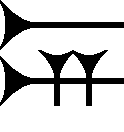
The cuneiform sign ni is a common-use sign of the Amarna letters, the Epic of Gilgamesh, and other cuneiform texts. It has a secondary sub-use in the Amarna letters for addressing the Pharaoh, from the vassal states of Canaan. The address to the Pharaoh is often 'King-Lord-Mine': LUGAL, EN-ia which has many varieties of expression. "LUGAL" is Akkadian language for "Šarru", English "king", and EN in Akkadian is bēlu, for "Lord",. In some Amarna letters the sub-use of ni is lí, for spelling "bēlu", be-lí often .
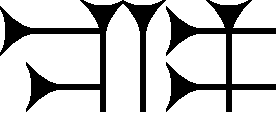
The cuneiform ta sign is a common, multi-use sign of the Epic of Gilgamesh, the 1350 BC Amarna letters, and other cuneiform texts. It also has a sumerogrammic usage for TA, for example in the Epic of Gilgamesh, for Akkadian language "ultu", English language for from, or since, but in only (1) location in the 12 tablet Epic of Gilgamesh. Sumerogram TA is used elsewhere in the Epic, (7) more times.

The cuneiform sign za is a common use sign in the Amarna letters and the Epic of Gilgamesh. It is used syllabically for ṣa, za, and ZA, and alphabetically for "ṣ" (s), "z", or "a".

The cuneiform sign ba, is a common-use sign of the Amarna letters, the Epic of Gilgamesh, and other cuneiform texts.

The cuneiform sign tap, or tab, is a common use sign in the Amarna letters and the Epic of Gilgamesh. It is used syllabically for tab, tap, ṭap, or TAB,, and alphabetically for "t", or "a".
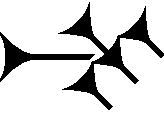
The cuneiform sign mu, is a common-use sign of the Amarna letters, the Epic of Gilgamesh, and other cuneiform texts. It is also used as MU.

The cuneiform sign iš is a common use sign in the Amarna letters and the Epic of Gilgamesh. It is used syllabically for iš; also for mel, mil, and a Sumerogramic usage for IŠ. Alphabetically as "iš", its most common usage, it can be used for "i" or "š". In Akkadian, the four vowels a, e, i, o, are all interchangeable, and the three different "s", can also be interchanged: s, ṣ, š.

The cuneiform sign hal, is a common-use sign in the Epic of Gilgamesh, the Amarna letters, and other cuneiform texts, for example Hittite texts. Its common usage is syllabic for hal, but could also be use for alphabetic h or l, or the a, and for the other three vowels of e, i, or u.
